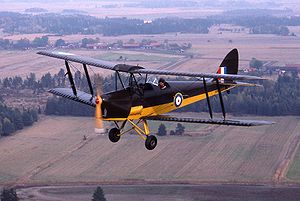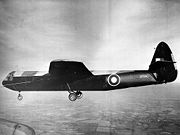
No. 670 Squadron RAF
Encyclopedia
No. 670 Squadron RAF was a glider
squadron of the Royal Air Force
active during the Second World War.
, Punjab
, (then) British India on 14 December 1944 as a glider squadron, with the intention of being used for airborne operations by South East Asia Command
. It continued to train, as part of No. 343 Wing RAF, until the surrender of Japan
, when it became surplus to requirements. The squadron was disbanded on 1 July 1946 at Chaklala, Punjab, British India.



Military glider
Military gliders have been used by the military of various countries for carrying troops and heavy equipment to a combat zone, mainly during the Second World War. These engineless aircraft were towed into the air and most of the way to their target by military transport planes, e.g...
squadron of the Royal Air Force
Royal Air Force
The Royal Air Force is the aerial warfare service branch of the British Armed Forces. Formed on 1 April 1918, it is the oldest independent air force in the world...
active during the Second World War.
History
No. 670 Squadron was formed at FatehjangFateh Jang
Fateh Jang is a town and the tehsil headquarters of Attock District in the Punjab province of Pakistan...
, Punjab
Punjab region
The Punjab , also spelled Panjab |water]]s"), is a geographical region straddling the border between Pakistan and India which includes Punjab province in Pakistan and the states of the Punjab, Haryana, Himachal Pradesh, Chandigarh and some northern parts of the National Capital Territory of Delhi...
, (then) British India on 14 December 1944 as a glider squadron, with the intention of being used for airborne operations by South East Asia Command
South East Asia Command
South East Asia Command was the body set up to be in overall charge of Allied operations in the South-East Asian Theatre during World War II.-Background:...
. It continued to train, as part of No. 343 Wing RAF, until the surrender of Japan
Surrender of Japan
The surrender of Japan in 1945 brought hostilities of World War II to a close. By the end of July 1945, the Imperial Japanese Navy was incapable of conducting operations and an Allied invasion of Japan was imminent...
, when it became surplus to requirements. The squadron was disbanded on 1 July 1946 at Chaklala, Punjab, British India.

Present
The squadron today is represented by 670 Squadron of 2 (Training) Regiment, Army Air Corps.
Aircraft operated

| From | To | Aircraft | Version |
|---|---|---|---|
| January 1945 | June 1945 | Hadrian Waco CG-4 The Waco CG-4 was the most widely used United States troop/cargo military glider of World War II. It was designated the CG-4 by the United States Army Air Forces, and named Hadrian in British military service.... |
|
| July 1945 | July 1946 | de Havilland Tiger Moth De Havilland Tiger Moth The de Havilland DH 82 Tiger Moth is a 1930s biplane designed by Geoffrey de Havilland and was operated by the Royal Air Force and others as a primary trainer. The Tiger Moth remained in service with the RAF until replaced by the de Havilland Chipmunk in 1952, when many of the surplus aircraft... |
Mk.II |
| December 1945 | June 1946 | Airspeed Horsa Airspeed Horsa The Airspeed AS.51 Horsa was a British World War II troop-carrying glider built by Airspeed Limited and subcontractors and used for air assault by British and Allied armed forces... |
Squadron bases
| From | To | Base |
|---|---|---|
| 14 December 1944 | 30 May 1945 | Fatehjang Fateh Jang Fateh Jang is a town and the tehsil headquarters of Attock District in the Punjab province of Pakistan... , Punjab Punjab region The Punjab , also spelled Panjab |water]]s"), is a geographical region straddling the border between Pakistan and India which includes Punjab province in Pakistan and the states of the Punjab, Haryana, Himachal Pradesh, Chandigarh and some northern parts of the National Capital Territory of Delhi... , British India |
| 30 May 1945 | 1 June 1945 | Dhamial Dhamial Dhamial is a village of Rawalpindi District in the Punjab province of Pakistan. It is located at 33°33'0N 73°1'0E with an altitude of 492 metres . The village gets its name from the Dhamial tribe.... , Punjab, British India |
| 1 June 1945 | 23 June 1945 | Basal, Punjab, British India |
| 23 June 1945 | 26 July 1945 | Upper Topa Camp, Punjab, British India |
| 26 July 1945 | 1 April 1946 | Fatehjang, Punjab, British India |
| 1 April 1946 | 1 July 1946 | Chaklala, Punjab, British India |

